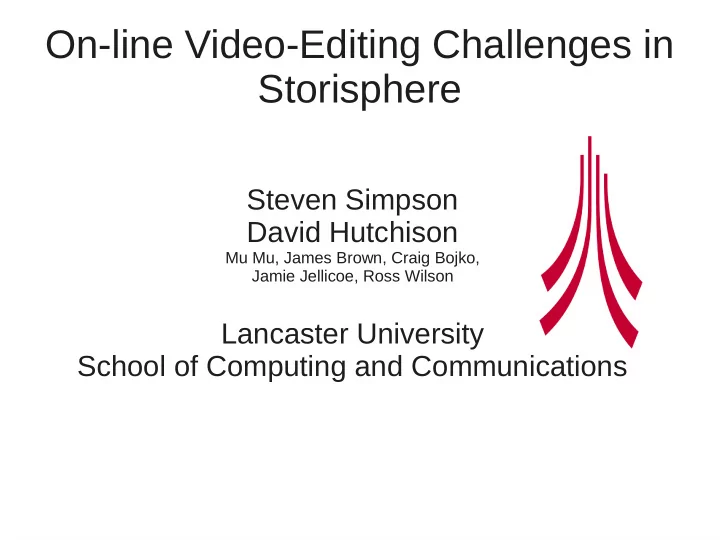

On-line Video-Editing Challenges in Storisphere Steven Simpson David Hutchison Mu Mu, James Brown, Craig Bojko, Jamie Jellicoe, Ross Wilson Lancaster University School of Computing and Communications
Storisphere aims ● Support collaborative storytelling – Like SourceForge/GitHub, but for video – Aimed at 'hyperlocal TV', community production – Support audio/video, stills, and audio commentary ● Edit on slim client devices – Web front-end – Minimal configuration – Server does the hard work – Cache and decode on client for playback
Editing on slim clients player server version 1 editing instructions version 2 editing instructions version 3
Content preparation ● Separate video and audio tracks. ● Split each track into independent chunks. – On GOP boundaries – Using closed GOPs – Publish as static files ● Write a rush EDL (edit-decision list) to recombine them into the original. – One EDL segment per chunk
EDL Composition new movie EDL segment segment segment source movies
Content retrieval ● Convert chunk-describing segments into MPEG-4 structural data. ● Add URI references to chunk files. ● Send to player. ● Player parses structural data and fetches chunks. ● Cache chunks for re-use!
Benefits of EDLs ● All derived content expressed as small text documents – Combine segments from separate rushes – Once ingested, no need for further transcoding ● EDL hierarchy – Can reference rush EDLs or other derived content – Build up advanced stories in stages – Track origins – Defer choice of resolution until point of playback
Recursive EDLs EDLs Rush EDLs
EDL resolution A B C A' time 10 40 50 70 70 80 200 200 220 260 90 280 280 140 150 110 180 210
Challenges ● EDLs ● Player – Missing functionality – Rational numbers ● MPEG-4 edit lists ● Propagation of prime ● External chunks ● 64-bit integers factors – Inefficient implementation ● MPEG-4 format ● No playback until all chunks fetched – Limited effects – Faulty implementation ● No visual combination ● Chunks abandoned ● Mixed audio frequencies ● Fixed audio volume ● Lingering stills – 32- or 64-bit limits ● Mixed aspect ratios
Solutions: Rational numbers ● Limited set of frame rates – Numerator of rate becomes denominator of frame durations: 30000/1001=29.97Hz => 30000 MPEG- 4 timescale ● Record ideal 'cut' positions. – Frame boundaries – Editor forbids cutting at arbitrary positions
Solutions: MPEG-4 format ● Don't do effects! – Audio overlays okay, though ● Lose some accuracy in generation of MPEG-4 edit list. – Shouldn't be easily perceptible
Solutions: Player ● Force use of QuickTime – Good support for edit lists ● Use a kerbside stitcher – Gets round bad/missing implementations of external chunk fetching ● Ingest at only one audio quality (44.1kHz) ● JIT translation of stills into 'very slow' edits ● Put up with aspect-ratio problems
Kerbside stitcher player integrated file GET range 10000-20000 stitcher structural data cache chunks server
Better solution: Our own player ● Requirements – Needs to be in JavaScript for maximum portability – Needs access to native decoder ● Byte-based, not file/URI-based ● Benefits – Not limited by MPEG-4 – Could do our own effects – Build the stitcher into the player
Links http://one.lancs.ac.uk/ Storisphere: collaborative video editing system (formerly “ONE”)
Acknowledgements FIRM http://www.firm-innovation.net/ Storisphere, and especially its MARS component, have developed from the Open Narratives Environment (ONE), conceived by colleagues from BBC Research and Development at MediaCityUK (Michael Sparks and Adrian Woolard), subsequently taken forward by Adam Lindsay and others at Lancaster University. We greatly acknowledge their contribution to the work documented herein.
Recommend
More recommend